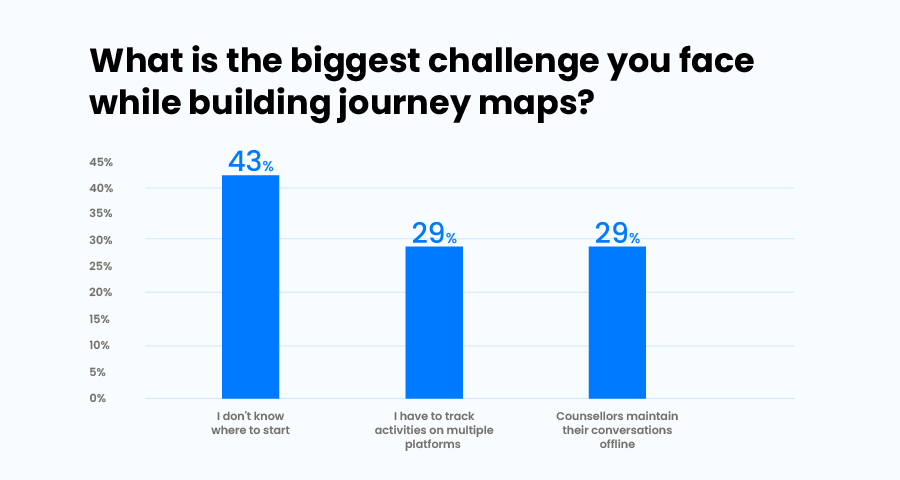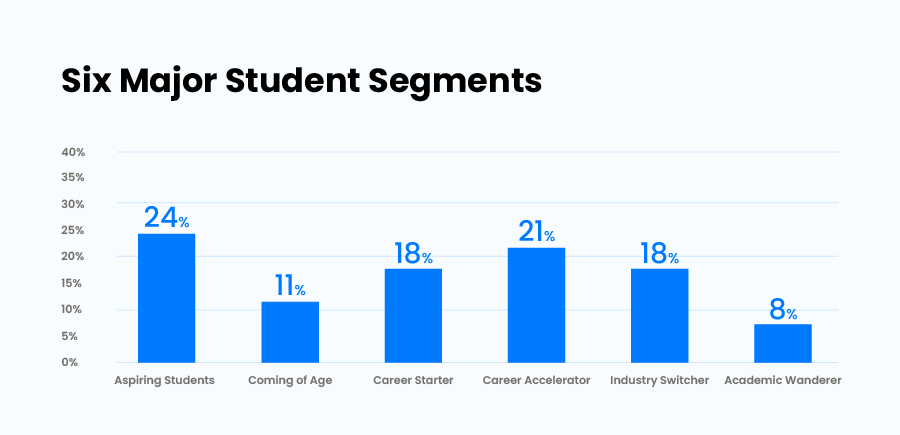A student journey map represents the journey of a prospective student from inquiry to enrollment and thereafter. Effective student journey mapping helps counselors drive personalized and context-driven conversations to support students. This translates into better student conversions and fewer drop-offs in the admission process.
Let’s take an example of how it can help higher education institutes get more student applications –
The student has done their research; they know the course they want to apply for and narrow it down to 2 Universities. They go to University A’s website to fill in a detailed inquiry form sharing their academic background, the course they’re interested in, and when do they plan to start. Then, the student goes to University B’s website, checks the course details, and fills in a shorter form.
With University A, they got an email saying, ‘Thank you for your interest; someone from the team will contact you shortly.’. Then, they get radio silence.
However, with University B, although they filled in a shorter form, they received an email with the prerequisites of the course they’re interested in and a counselor on call who shared the details about how to fill in the application online.
No marks for guessing where the student will apply for the course. University B was able to convert the student from the inquiry stage to the application stage just because they had a detailed student journey map.
We hosted a webinar on the “Role of Student Journey Mapping to Drive Conversions.”. The speakers shared some great insights on how technology helped them build these maps and nurture students throughout their application journey.
We were joined by Jatin Arora, Vice President–Business, Leverage Edu, Libu Thomas, Head of Business, Admitkard, and Sachita Mehra, Director-Strategic Accounts, .
During the webinar, we asked our audience the biggest challenge they faced while building journey maps. 43% of them answered that they didn’t even know where to begin!

This article details how universities can build those maps, the role that technology plays in them, and the common mistakes to avoid.
Let’s get started!
What is Student Journey Mapping?
Student journey mapping is a visual representation of the student experience, from the initial inquiry to graduation and beyond. It serves as a powerful tool for higher education institutions to understand the student’s perspective, identify pain points, and enhance the overall student experience. By meticulously mapping out the student journey, institutions can gain valuable insights into the needs and expectations of their students, enabling them to make data-driven decisions that boost student engagement, retention, and success.
In essence, a student journey map allows colleges and universities to see the entire student lifecycle through the eyes of their students. This holistic view helps in pinpointing areas where students might face challenges and provides opportunities to improve their journey. Whether it’s streamlining the application process, enhancing academic advising, or improving student services, a well-crafted student journey map is instrumental in creating a supportive and engaging environment for all students.
What Does Effective Student Journey Mapping Look Like?
“Build a discovery to dorm approach – help a student be prepared from applying to a university till they actually start studying there.”
Jatin Arora, Vice President-Business, Leverage Edu
Here are some important aspects to evaluate the effectiveness of your student journey maps. These will help you understand how these maps can impact conversions as well as student experience.
1. Identify the different touchpoints and friction points
There will be multiple steps a student has to go through before actually getting enrolled into the course. Each step must have a touchpoint (a channel of communication) from your end. In our earlier example, it was the form, the email, and the phone call.
While you identify the touchpoints, also take note of the points that might cause friction to the student. For example, a lengthy website form. Instead, you can either use a shorter form or have a robust Higher Education CRM that could save that data in the student’s application portal.
2. Build resources to address student FAQs
When you are living through the journey a student takes, identify the common areas where one might get stuck or drop off. Have your team reach out to students to help them by building a repository of answers and short explainer videos for better understanding.
3. Don’t rely on your student to come back to complete the form
If you think your prospect is going to come back to fill in the application form, you are mistaken. The thought of “filling the form later” oftentimes won’t cross their minds. They will leak out of the funnel and you will have to work even harder to get the attention of the next student.
4. Sharing relevant information isn’t intrusive
If you think your student journey has too many touchpoints, then re-evaluate. Are you sharing information that they truly require? Or is it just something to keep us on their radar? Sharing information that they are looking for will make them appreciate what you share and be more receptive towards you.
5. Create a frictionless process
We cannot stress it enough. Keep your application as simple as it can get. Whether it is trying to find more information or uploading documents—make it as easy as possible. You can use different channels to reach out to them and ensure your application forms are self-explanatory.
5 Steps to building a student journey map
Let’s look at how can one get started with building a student journey map. It’s important to remember student journey mapping doesn’t stop at the enrolment stage. It takes the entire student journey into account, from the first interaction with your college to the students’ lives beyond education, as an alumnus.
Step 1: Define your student personas
The first step is to establish who your key student personas are, i.e. the people who are likely to apply and enrol in a program at your college.
Once complete, you can use them as a springboard for ideas that will help you refine your messaging, create successful conversion funnels and, ultimately, increase conversions.
There’s no strict template to follow, but you could aim to include the following information in each student persona:
- A name
- A summary describing their day-to-day life and motivations
- Relevant demographic details (location, educational background, age)
- Ambitions and challenges
- Information sources (social media, school, relatives etc.)
- Testimonial extracts from existing students
Following an analysis of an extensive student survey, The Parthenon Group created segments based on what people hoped to achieve following their bachelor’s degree.
…it is important to understand the deeper motivations of students to better meet their needs and compete in an evolving higher education market.
The Differentiated University, The Parthenon Group

Step 2: Map the student journey
Once you’ve established your student personas, it’s time to plot the student journey. When, where, and how do people interact with your college?
An individual’s student journey starts at the point at which they find out about your college, whether it’s through word of mouth or by seeing an ad on social media.
Broadly speaking, you can divide the student journey into six phases:
- Discovery
- Evaluation
- Application
- Enrolment
- Retention
- Loyalty
Of course, every education provider—and program—is unique, and yours might differ slightly.
Breaking down the student journey in this way can help you understand the student experience better and help you identify challenges and opportunities.
Step 3: Pinpoint student touchpoints
How do students interface with your institution?
Where do they go to find out about program requirements, start dates, student finance options (including scholarships), and accommodation?
To better understand each persona’s journey, identify their typical touchpoints. This exercise should be a collaborative one involving the admissions and marketing teams.
Common student-college touchpoints include:
- Your college’s website
- Social media channels (e.g. LinkedIn, Instagram, TikTok)
- Downloadable content (brochures, course curriculum, etc.)
- Email exchanges
- SMS texts
- The application portal
- Campus visits and virtual events
Next, work out which stage in the student journey the touchpoint corresponds with.
For instance, social media may correspond with the “discovery” and “alumnus” stages best.
Step 4: Investigate what works well and what doesn’t
Now you’ve identified your personas, their journey, and touchpoints, it’s time to dig deeper into how successful you are at engagement.
How many prospective students go on to apply after downloading a prospectus, for example? What are your student retention ratios for different personas, and at which point is a student most likely to drop out (i.e. in their first year of study)?
Tracking movement is where a Higher Education CRM comes in handy.
You don’t have to rely on Google Analytics. Your Higher Education CRM should enable you to track students’ activity on your website, ads, and social media with ease.
Step 5: Apply what you’ve learned today
After honing on what works well and where there’s room for improvement, you can start to make a real difference by planning and implementing fresh strategies.
One of the most effective ways to do this is by taking a cross-departmental approach, bringing in the ideas and expertise of teachers and non-teaching staff alike.
In today’s largely automated world, students have come to expect a streamlined and personalized experience. Again, your CRM can be a critical toolbox when it comes to facilitating new and improved approaches.
Best Practices for Student Journey Mapping
Creating a student journey map involves several best practices to ensure it accurately reflects the student experience and identifies areas for improvement.
First and foremost, students should be involved in the mapping process. This can be done through surveys, focus groups, or one-on-one interviews, ensuring that the map is grounded in real student experiences.
Next, identify all touchpoints between the student and the institution. This includes interactions with academic programs, student services, and support systems. By mapping out these touchpoints, you can gain a comprehensive understanding of the student journey and identify potential friction points.
The map should also be visual and easy to understand. Use clear and concise language, avoiding jargon, and consider incorporating visual elements like flowcharts or infographics to make the map more engaging.
Finally, the map should be regularly reviewed and updated to reflect changes in the student experience and institutional priorities. This ensures that the map remains a relevant and useful tool for improving the student journey.
How Can a Higher Education CRM Help You Enhance Student Journey?
Right from choosing the channel of communication, and the messages you send out to taking corrective action, a Higher Education CRM will help you engage and enhance the student’s journey. Here’s why a CRM will help you implement and improve your student journey maps –
1. Drive personalized conversations
An higher education CRM will track all the activities a student undertakes while applying to your university. The pages they browse, the forms they leave half-finished, or the videos they view–all of this will be tracked. This goldmine of information can help your counselors drive more personalized conversations and you can also set up triggers to send out messages.
2. Make timely interventions
If your counselor can get notified that a student is browsing through the financial aid section and make a call explaining the various options they have, the student will be more receptive to that information. Like I mentioned earlier, if you share information that the student is actually looking for, they will be more loyal towards you.
Through technology we can give every student a checklist to prepare for the next stage. It allows you reach out to the student at a timely manner. And we were able to do this with the help of LeadSquared.
Libu Thomas, Head of Business, Admitkard
3. Have data-driven insights
Creating a journey map is a whole lot of learning, unlearning, and relearning. With the help of an Higher Education CRM, you get to learn more about the application, unlearn the unnecessary steps causing friction, and relearn which steps to remove or improve during the entire journey. And the whole process is driven by data and insights.
4. Help train counselors
Whatever interactions your counselors have with the student is captured in the CRM. The call recordings, demo notes, and customer feedback prove to be helpful in training other counselors on how to hold conversations, identify messages that resonate the most, and capture the gaps that need to be filled.
5. Identify qualified opportunities
The CRM can capture cues as to which student is more likely to convert. This will help your counselors prioritize the ones that are moving down the funnel rather than respond to queries as they come.
For example, a student has filled out an inquiry through a specific course page vis-a-vis a student dropped in a generic inquiry. The first student has shown a higher intent to enrol in the course, so the counselor should call them first. An effective lead management software can help you achieve this with its quality scoring and lead prioritization features.
6. Help nurture students
Not all students that discover you are ready to study with you. Some might also be trying to get a head start to understand what it takes to study at your university. Just so that you don’t lose touch with these students, a CRM can help you nurture them till they are ready to begin their journey.
Thanks to LeadSquared we’ve been able to map detailed student journeys that helped us nurture students that still have 2 or 3 years ahead in the journey. We can automate this engagement till the students are ready to start their journey with us.
Jatin Arora, Vice President–Business, Leverage Edu
Mistakes to Avoid While Building Journey Maps
Here are some common mistakes to avoid when you start building your student journey maps
1. Not living a student’s journey
Unless you don’t go through the process yourself, you won’t be able to identify the touchpoints and friction points that your student persona might face. Going through the student’s journey will help you improve the process better since you have first-hand experience.
2. Ignoring the cracks based on our biases
This is one of the most common and honest mistakes admissions teams make while building student journey maps. You shouldn’t ignore a leak in your funnel based on personal biases. It’s like running a scientific experiment–keep it unbiased and random.
3. Not identifying the holes in our funnel
Missing out on a leak is one thing, but if you can’t identify the leak—that’s an entirely different problem. If there are 5 milestones that the student needs to complete before enroling with you, then there are 5 potential stages from where the student can move out the funnel.
With the help of a Higher Education CRM, you will be able to identify these leaks and nurture them further till they are ready to get back into the funnel.
4. Not applying the learnings
After you take note of the entire process, apply it, and learn new outcomes with the help of your CRM, it is important that you apply them. Remember unlearning and relearning is just as important to build better journey maps.
You can keep tabs on a number of education KPIs or build detailed reports to understand student behaviour and improve the admissions process.
Wrapping Up
I hope this article has not only helped you get started with building student journey maps but has also helped you identify the scope of improvement in your current one.
In the age of expensive online ads, too much competition, and even shorter attention spans, it is important to adopt the right processes and technologies that help you engage and retain your students better.
If you’re looking to improve student engagement through technology, give LeadSquared for Education a try. Get in touch with our team to learn how you can build detailed journey maps and improve student experience.
FAQs
How do I get started with creating a student journey map for my institution?
Start small and build. Here’s a breakdown:
1. Identify key stakeholders: Involve representatives from admissions, marketing, academic advising, and other departments that interact with students throughout their journey
2. Define student personas: Create profiles of your ideal students, considering demographics, academic goals, and challenges. This helps tailor the map to their specific needs.
3. Outline key touchpoints: Identify all the interaction points students have with your institution, from initial research to enrollment and beyond. Consider online channels, in-person events, and communication with staff.
What tools canbe used to create a student journey map?
Many options exist. Here are some considerations:
1. Online collaboration tools: Utilize online whiteboarding or collaborative mind-mapping tools to brainstorm and visually map the student journey with your team.
2. Design software: Software like Figma or even presentation tools like PowerPoint can be used to create a more polished and visually appealing student journey map.
3. Customer journey mapping templates: Many online resources offer pre-made student journey map templates that you can customize for your institution.
How often should we update our student journey map?
Regular updates are crucial. Here’s why:
1. Evolving landscape: The student recruitment and education landscape changes. Regularly revisit your map to ensure it reflects current trends, admissions processes, and student expectations.
2. Feedback incorporation: Gather feedback from students, faculty, and staff to identify areas for improvement and incorporate them into your student journey map.
3. Data insights: Analyze data on student behavior and engagement to identify any gaps or inconsistencies between the mapped journey and the actual student experience.












